
Leon Albert "Bud" Edney is a former United States Navy officer. A native of Dedham, Massachusetts, he retired from the Navy as an admiral and served as vice chief of naval operations for the United States Navy.

Vice Admiral Daniel Edward Barbey was an officer in the United States Navy who served in World War I and World War II. A graduate of the Naval Academy, he participated in the 1912 United States occupation of Nicaragua and the 1915 United States occupation of Veracruz. While serving with the War Plans Section of the Bureau of Navigation in Washington, D.C. between the World Wars, developed an interest in amphibious warfare. In 1940 he produced Fleet Training Publication 167 – Landing Operations Doctrine, United States Navy, which would become the Navy's "bible" of amphibious operations, and would remain in use throughout World War II.
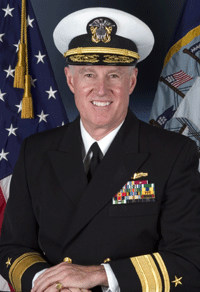
Rear Admiral William VanMeter Alford Jr. was the chief of staff for the United States Pacific Command between August 2004 and September 2007.

Admiral William Floyd Bringle was a senior officer in the United States Navy. He was the first commanding officer of USS Kitty Hawk (CV-63), commanded the United States Seventh Fleet from 1967 to 1970 during the Vietnam War, and as commander, United States Naval Forces Europe from 1971 to 1973.

Roy Lee Johnson was a highly decorated four-star Admiral in the United States Navy. A Naval Academy graduate, he trained as Naval aviator and distinguished himself as Air Group Commander during several World War II campaigns.

Rear Admiral Tony Lee Cothron was the Director of Intelligence for the Chief of Naval Operations and the 62nd Director of Naval Intelligence. He is currently a professor at Liberty University.

Waldemar Frederick August Wendt was a four-star admiral in the United States Navy who served as commander in chief of United States Naval Forces Europe from 1968 to 1971.

Ephraim Paul Holmes was a four-star admiral in the United States Navy who served as commander in chief of the U.S. Atlantic Fleet and Supreme Allied Commander, Atlantic from 1967 to 1970.
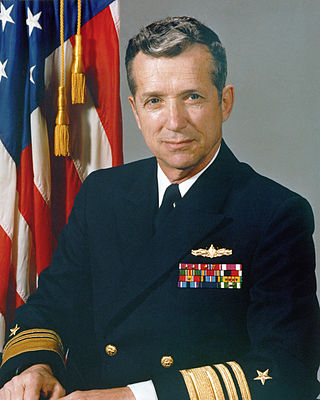
Joseph Metcalf III was a United States Navy vice admiral. He graduated from Vermont Academy in 1946 and then from the Naval Academy in 1951 and retired from active duty in 1987.
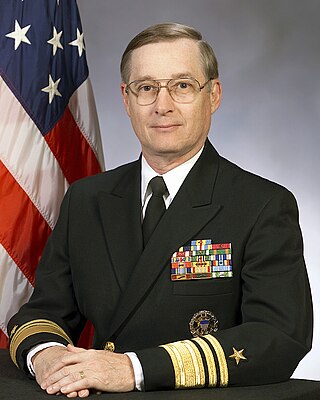
Vice Admiral Lowell Edwin Jacoby, USN was the 14th director of the Defense Intelligence Agency. Previously he was Director for Intelligence (J-2) Joint Staff in the Office of the Chairman of the Joint Chiefs of Staff from 1999 to 2002, and the Director of Naval Intelligence and commander, Office of Naval Intelligence from 1997 to 1999. He was the Director for Intelligence, U.S. Pacific Command from 1994 to 1997 and Commander, Joint Intelligence Center, Pacific from 1992 to 1994. He was Assistant Chief of Staff, Intelligence, U.S. Pacific Fleet from 1990 to 1992.

Samuel Perez Jr. is a retired rear admiral in the United States Navy.

Donald Bradford Beary was a vice admiral of the United States Navy. His career included service in both World War I and World War II and a tour as President of the Naval War College. He commanded a wide variety of ships and organizations, and is particularly noted for his leadership during World War II in establishing and directing a large-scale U.S. Navy training program and for his pioneering and highly successful work as a commander of U.S. Navy underway replenishment forces.
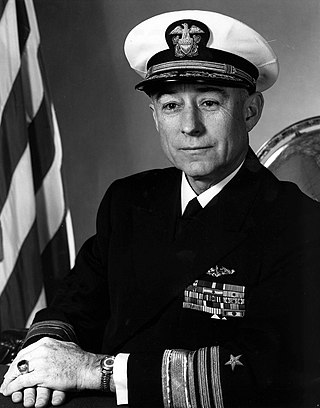
Bernard Lige Austin was a Vice Admiral of the United States Navy. His career included service in World War II, the Korean War, and the Cold War and command of submarines and surface ship forces, during which he became a distinguished combat commander of destroyers. He also commanded the United States Second Fleet, held numerous diplomatic, educational, and administrative staff positions, and a served a lengthy tour of duty as President of the Naval War College.

Charles Leroy Melson was a vice admiral of the United States Navy. His career included service in World War II, the Korean War, and the Cold War, command of the United States First Fleet and of the United States Taiwan Defense Command, and tours of duty as Superintendent of the United States Naval Academy and President of the Naval War College.

Julien Johnson LeBourgeois was a vice admiral of the United States Navy. His career included service in World War II, the Cold War, and the Vietnam War, duty aboard and command of cruisers and destroyers, various planning and staff assignments, and a tour as President of the Naval War College.

James R. Stark is a retired rear admiral of the United States Navy who served during the Cold War and in the Vietnam War and oversaw operations related to the Yugoslav Wars of the 1990s. A surface warfare officer, his career included command of ships at sea, senior U.S. Navy and North Atlantic Treaty Organization (NATO) commands, staff assignments with the Chief of Naval Operations and the National Security Council, and a tour as President of the Naval War College.
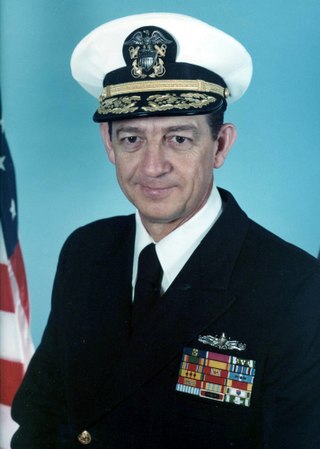
Vice Admiral Emmett Hulcy Tidd was a flag officer of the United States Navy.

Stephen Scott Clarey is a retired United States Navy rear admiral who commanded the U.S. Maritime Prepositioning Force during Operation Desert Shield and the Pacific Fleet/5th Marine Expeditionary Brigade Amphibious Task Force during Operation Desert Storm. He retired from the navy in August 1992 after thirty years of service.

Lynne Cline Quiggle was a rear admiral of the United States Navy. He saw service in World War II and in the Cold War before he was lost at sea in 1958.
Stanley Thomas Counts was a United States Navy admiral whose Cold War military service extended through the Korean War and Vietnam War.


















